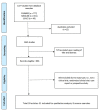Prospecting Local Treatments Used in Conjunction with Antivenom Administration Following Envenomation Caused by Animals: A Systematic Review
- PMID: 37235348
- PMCID: PMC10223778
- DOI: 10.3390/toxins15050313
Prospecting Local Treatments Used in Conjunction with Antivenom Administration Following Envenomation Caused by Animals: A Systematic Review
Abstract
Envenomation caused by venomous animals may trigger significant local complications such as pain, edema, localized hemorrhage, and tissue necrosis, in addition to complications such as dermonecrosis, myonecrosis, and even amputations. This systematic review aims to evaluate scientific evidence on therapies used to target local effects caused by envenomation. The PubMed, MEDLINE, and LILACS databases were used to perform a literature search on the topic. The review was based on studies that cited procedures performed on local injuries following envenomation with the aim of being an adjuvant therapeutic strategy. The literature regarding local treatments used following envenomation reports the use of several alternative methods and/or therapies. The venomous animals found in the search were snakes (82.05%), insects (2.56%), spiders (2.56%), scorpions (2.56%), and others (jellyfish, centipede, sea urchin-10.26%). In regard to the treatments, the use of tourniquets, corticosteroids, antihistamines, and cryotherapy is questionable, as well as the use of plants and oils. Low-intensity lasers stand out as a possible therapeutic tool for these injuries. Local complications can progress to serious conditions and may result in physical disabilities and sequelae. This study compiled information on adjuvant therapeutic measures and underscores the importance of more robust scientific evidence for recommendations that act on local effects together with the antivenom.
Keywords: envenoming; local effects; local therapies; venomous animals.
Conflict of interest statement
The authors declare no conflict of interest.
Figures


References
-
- Schulz R.D.S., Queiroz P.E.S., Bastos M.D.C., Miranda E.A., Jesus H.D.S.D., Gatis S.M.P. Tratamento da ferida por acidente ofídico: Caso clínico. Cuid. Enferm. 2016;10:172–179.
-
- Sachett J.D.A.G., Val F.F., Alcântara J.A., Cubas-Vega N., Montenegro C.S., da Silva I.M., de Souza T.G., Santana M.F., Ferreira L.C., Monteiro W.M. Bothrops atrox Snakebite: How a Bad Decision May Lead to a Chronic Disability: A Case Report. Wilderness Environ. Med. 2020;31:317–323. doi: 10.1016/j.wem.2020.03.001. - DOI - PubMed
-
- Barreto G.N.L.S., de Oliveira S.S., dos Anjos I.V., Chalkidis H.D.M., Mourão R.H.V., Moura-Da-Silva A.M., Sano-Martins I.S., Gonçalves L.R.D.C. Experimental Bothrops atrox envenomation: Efficacy of antivenom therapy and the combination of Bothrops antivenom with dexamethasone. PLoS Negl. Trop. Dis. 2017;11:e0005458. doi: 10.1371/journal.pntd.0005458. - DOI - PMC - PubMed
Publication types
MeSH terms
Substances
LinkOut - more resources
Full Text Sources
Miscellaneous

